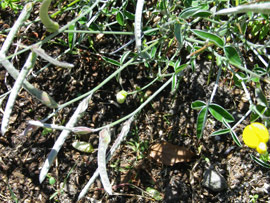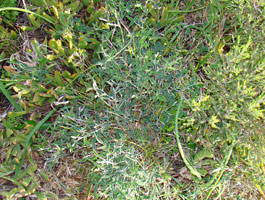Argyrolobium lunare
Argyrolobium lunare (L.) Druce subsp. lunare
Family: Fabaceae
Common names: None
Introduction
At first glance it looks as if there are two similar kinds of plant growing together. This is because most of the flowers are bright yellow and others are a rich russet. Closer inspection reveals that they are all growing on the same sprawling groundcover. The green leaflets appear to be edged with silver.

Description
Description
Argyrolobium lunare is a sprawling herbaceous perennial, sometimes scrambling up through other bushes, which varies considerably. Stems, flower stalks, leaf stalks and pods are all finely hairy. The anthers are also hairy, and this, together with the beaded appearance of the pod, help to distinguish it from other species in the Western Cape. The 15 mm long flowers look like those of a pea, are borne at the end of long flower stalks and are yellow, aging to russet or brick red after pollination. The calyx is divided into two, with the upper 'lip' having 2 lobes and the lower one 3. The pods are up to 60 mm long and indented between each seed, giving them a beaded appearance. They split open when mature and each half twists in a spiral, releasing the seeds. The leaves are on long stalks and divided into 3 leaflets, folded along their length, the upper surface is smooth and mid-green while the lower surface is covered with fine silvery hairs. Flowering occurs from August to February.


Conservation Status
Status
Listed as Least Concern (Raimondo et al. 2009).

Distribution and habitat
Distribution description
Both subspecies of Argyrolobium lunare grow on low altitude slopes below 300 m in the winter-rainfall region. A. lunare subsp. lunare is found in the Caledon district, growing right down to the coast. A. lunare subsp. sericium is fairly common in the southwestern Cape from Clanwilliam to the Riviersonderend Mountains. Both subspecies grow on soils associated with the Table Mountain Group of the Cape Supergroup.

Derivation of name and historical aspects
History
The generic name Argyrolobium is made up of two Greek words: Argyro is derived from 'argyros' for silver, and lobium from 'lobos' for pod.
In total there are ± 70 species in the genus Argyrolobium and they are widespread, being found in the area including Africa and southern Europe to India. About 50 of these occur in southern Africa, mostly in the eastern regions.
Ecology
Ecology
The change of flower colour from bright yellow to russet brown is thought to be a signal to plant pollinators, probably bees, that the flower has already been pollinated and that there are no longer rewards in the form of pollen or nectar for visiting the darker flowers. The long flower stalks lift the flowers above the leaves making them easier for pollinators to see and get to.
Uses
Use
Apart from its potential as a hardy garden plant, no other uses are currently known for this plant.

Growing Argyrolobium lunare
Grow
This is a very pretty, low-growing plant with a relatively long flowering period. The bright yellow and russet flowers are beautiful, as are the leaves with their silver edging of hairs. It deserves to become a favourite as a groundcover and edging plant in flower beds.
Cuttings have not been successful, but seed sown in autumn in a mixture of 50% well rotted fine pine bark and 50% coarse river sand gives reasonable results. Sprinkle the seeds in trays over the above mixture and then give them a topping of coarse river sand. Apply a drench of fungicide to prevent damping off. In the Harold Porter NBG the sown seed trays are then subjected to 3 hours of smoke treatment but smoke essence will probably work just as well. Trays are then sprayed with a fine spray and kept moist. Germination occurs in 4-6 weeks. Once primary leaves have emerged, water with a well diluted seaweed fertilizer. When large enough to pot up, transfer seedlings into bags with a mix of 70% rotted fine pine bark and 30% coarse river sand. Feed regularly with a mixture of 10 ml seaweed fertilizer in 10 l of water.
The only pest noticed on the plant has been mealy bug which can be sprayed with an appropriate insecticide.
References
- Adamson, R.S. & Salter, T.M. (eds) 1950. Flora of the Cape Peninsula, Juta, Cape Town.
- Bean, A. & Johns, A. 2005. Stellenbosch to Hermanus. South African Wild Flower Guide 5. Botanical Society of South Africa Cape Town. BURMAN, L. & BEAN, A. 1985. Hottentots Holland to Hermanus. South African Wild Flower Guide 5. Botanical Society of South Africa, Cape Town.
- Edwards, T.J. 2005. A synopsis of Argyrolobium (tribe Genisteae, Papilionoideae) in South Africa. South African Journal of Botany 71 (3): 380-417.
- Germishuizen, G., Meyer, N.L., Steenkamp, Y. & Keith, M. (eds) 2006. A checklist of South African plants. Southern African Botanical Diversity Network Report No. 41. SABONET, Pretoria. Goldblatt, P. & Manning, J. 2000. Cape Plants. A conspectus of the Cape Flora of South Africa. Strelitzia 9, National Botanical Institute of South Africa & MBG Press, Missouri Botanical Garden, USA.
- Kesting, D. (compiler) 2001. Wild flowers of the Cape Peninsula. Botanical names: Origin and meaning. Flora Documentation Project, Friends of the Silvermine Nature Area, St James.
- Leistner, O.A. (ed.) 2000. Seed plants of southern Africa: families and genera. Strelitzia 10. National Botanical Institute, Pretoria.
- Raimondo, D., VonStaden, L., Foden,W., Victor, J.E., Helme, N.A.,
- Turner, R.C., Kamundi, D.A. & Manyama, P.A. (eds) 2009. Red List of South African Plants 2009. Strelitzia 25. South African National Biodiversity Institute, Pretoria.
Credits
Jane A Forrester
Harold Porter National Botanical Garden
July 2012
Plant Attributes:
Plant Type: Ground Cover, Perennial, Scrambler
SA Distribution: Western Cape
Soil type: Sandy
Flowering season: Spring, Early Summer, Late Summer
PH: Acid
Flower colour: Brown, Yellow
Aspect: Full Sun
Gardening skill: Average
Special Features:
Horticultural zones







Rate this article
Article well written and informative
Rate this plant
Is this an interesting plant?
Login to add your Comment
Back to topNot registered yet? Click here to register.